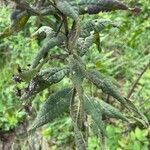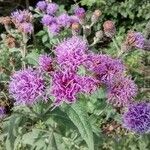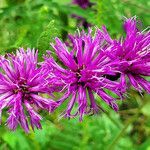Stem stout, 1–2 m, pubescent or thinly tomentose; lvs lanceolate, 6–20 × 1.5–6 cm, coarsely serrate to subentire, scabrellate above, thinly to densely tomentose beneath, at least along the veins, with long, crooked hairs; infl widely branched, flattened or concave; fls 32–58; invol bracts appressed, purple, or greenish along the inconspicuous midvein, rounded to acute, often apiculate, arachnoid-ciliate, glabrous or puberulent on the back; pappus tawny to brown; 2n=34. Moist prairies, bottomland pastures, and low roadsides; sw. Ont. to Io. and Nebr., s. to Ala. and Tex. Our plants mostly contaminated by introgression from no. 5 [Vernonia gigantea (Walter) Trel.]
A shrub.



